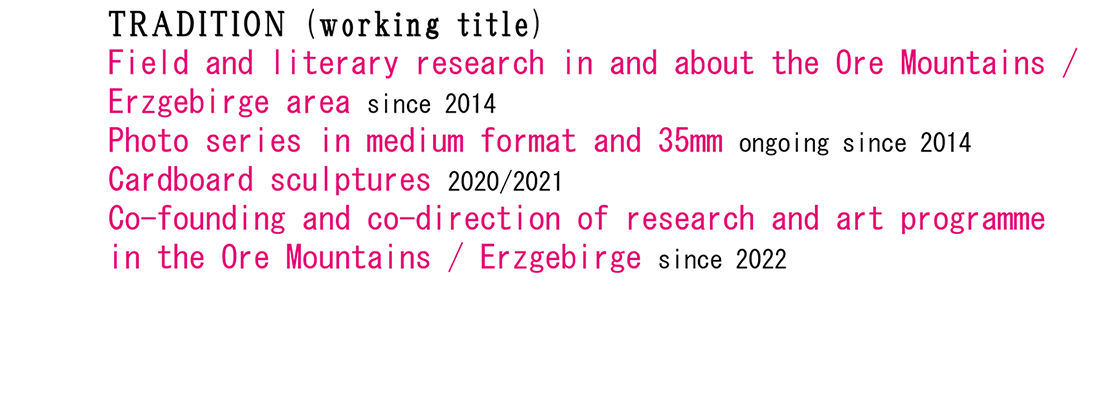
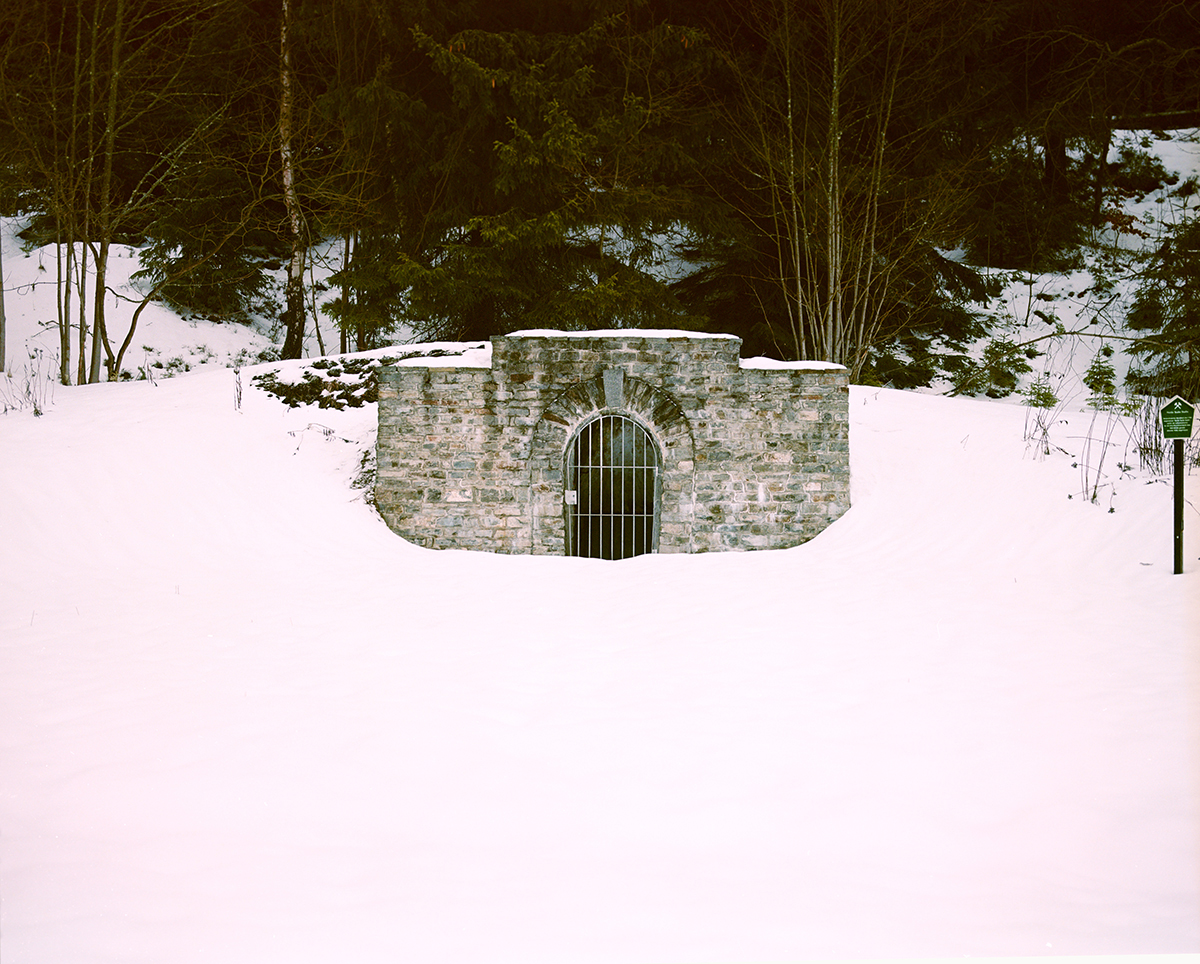 "Mundloch" (German for "mouth hole"), adit opening to the historic mine Weiße Taube Stollen, Johanngeorgenstadt.
"Mundloch" (German for "mouth hole"), adit opening to the historic mine Weiße Taube Stollen, Johanngeorgenstadt.
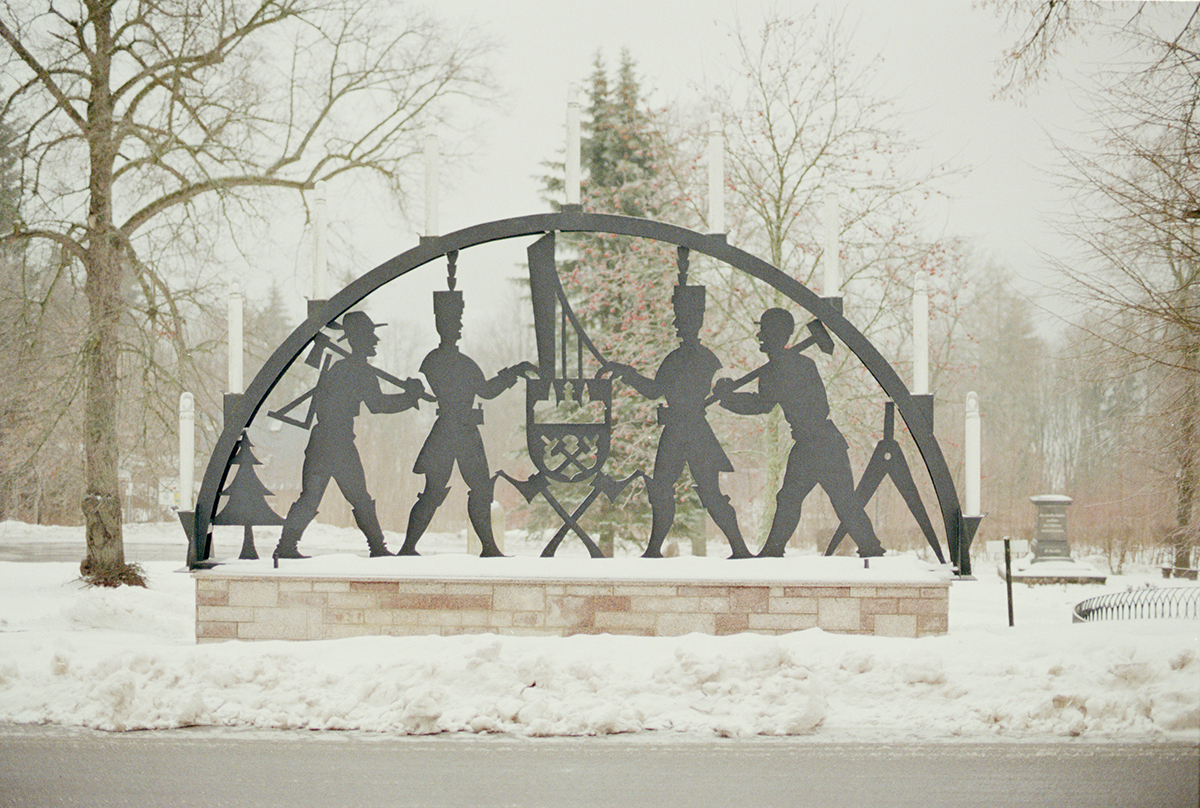 Village Schwibbogen with socialist motive built in the GDR, Johanngeorgenstadt.
Village Schwibbogen with socialist motive built in the GDR, Johanngeorgenstadt.
 Garage, Johanngeorgenstadt. Meeting point of the extremist rightwing group Brigade Ost and one of the helping hands of the National Socialist Underground (NSU), the terror group that assassinated based on racist motives, André Eminger. For a few years the right-wing populist party AfD sweeps seats in the parliament in Saxony (where the Erzgebirge is located). New political groups like Freie Sachsen, as well as old neo-nazi formations, continue to remain present in the daily lives of the inhabitants. In the 90s, attacks against "Ausländer", foreigners, were in the news regularly through my childhood. They still happen in Germany, not only in the former East. I was also affected by xenophobic and racist hate in elementary school.
Garage, Johanngeorgenstadt. Meeting point of the extremist rightwing group Brigade Ost and one of the helping hands of the National Socialist Underground (NSU), the terror group that assassinated based on racist motives, André Eminger. For a few years the right-wing populist party AfD sweeps seats in the parliament in Saxony (where the Erzgebirge is located). New political groups like Freie Sachsen, as well as old neo-nazi formations, continue to remain present in the daily lives of the inhabitants. In the 90s, attacks against "Ausländer", foreigners, were in the news regularly through my childhood. They still happen in Germany, not only in the former East. I was also affected by xenophobic and racist hate in elementary school.
 Farmstead with traditional christmas star, Deutschneudorf, 2014
Farmstead with traditional christmas star, Deutschneudorf, 2014
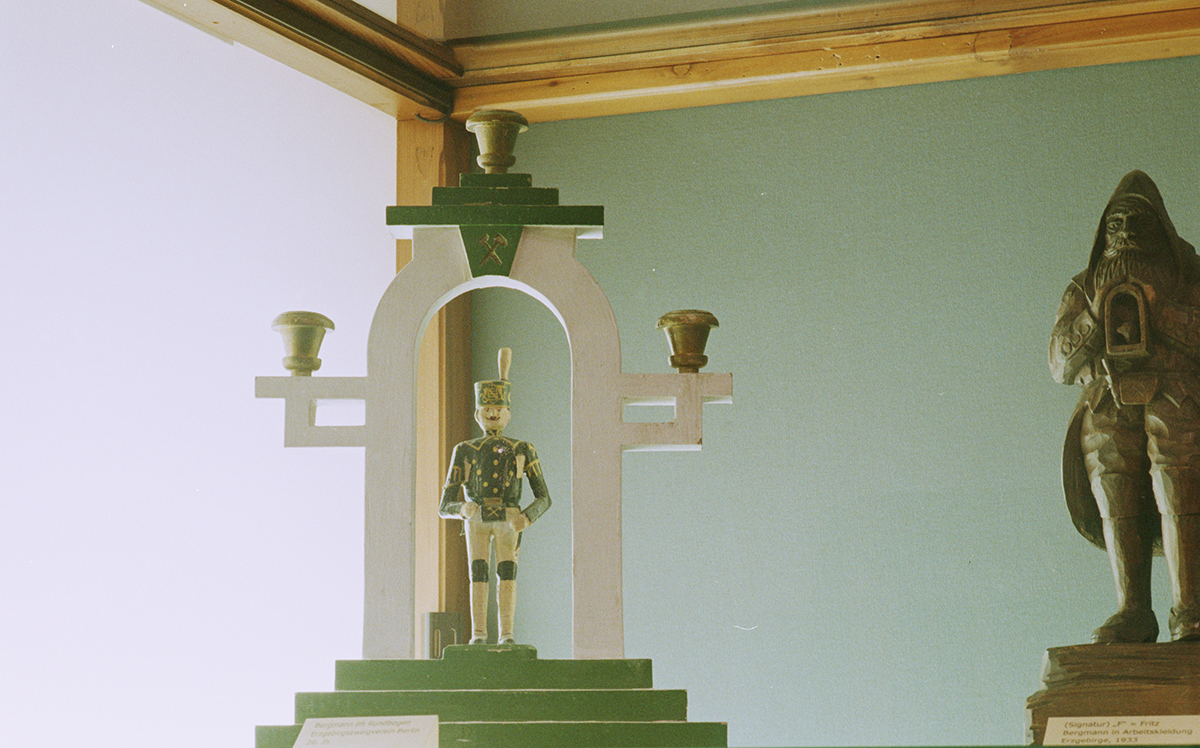 Miner figures in one of the many local "Heimat" museums, small museums dedicated to folk art. In the case of the Ore Mountains, the term folk art has been misappropriated to also mean the mass productions made for the international market. The woodworking turn happened after the mining industry ran dry.
Miner figures in one of the many local "Heimat" museums, small museums dedicated to folk art. In the case of the Ore Mountains, the term folk art has been misappropriated to also mean the mass productions made for the international market. The woodworking turn happened after the mining industry ran dry.
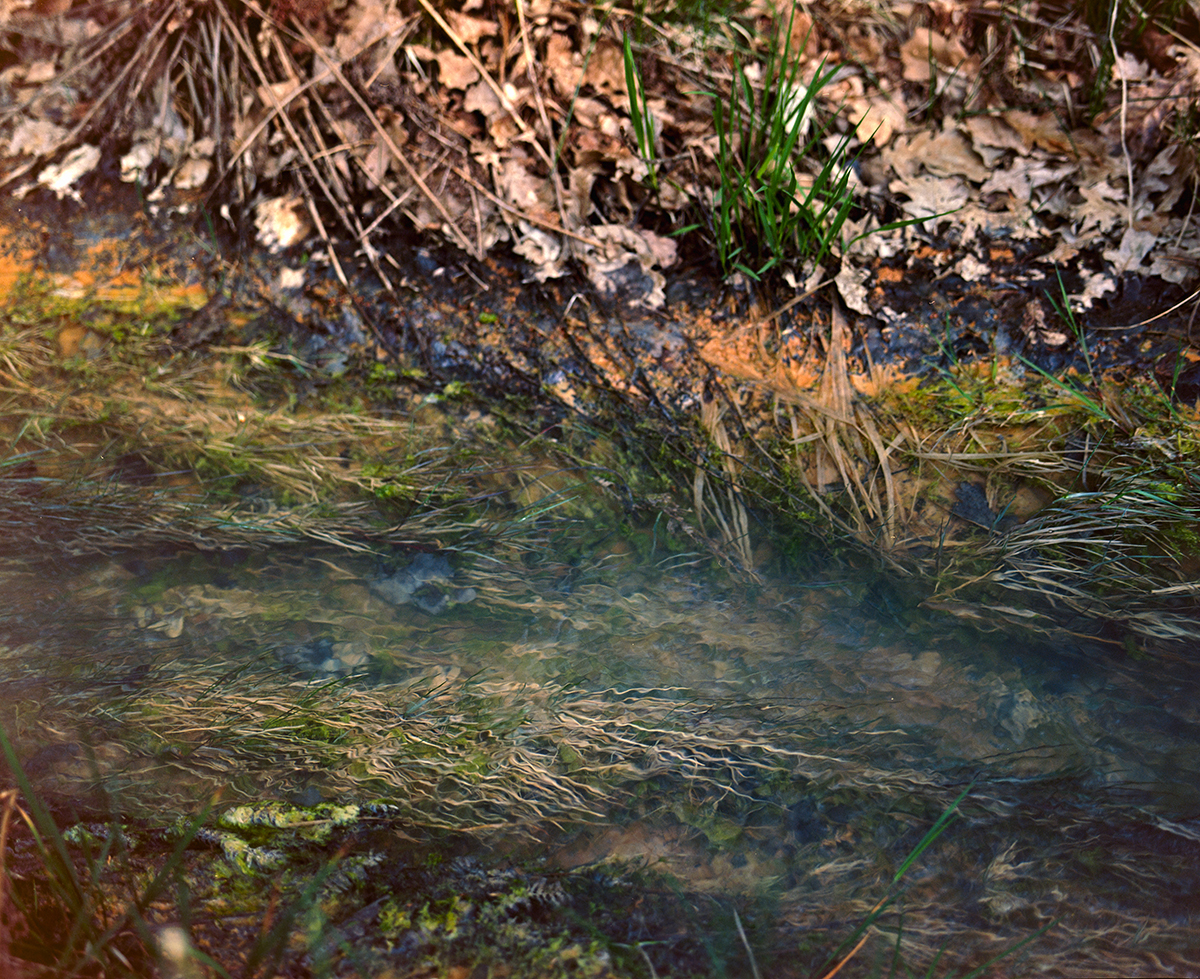 Roter Graben, water inflow for historic mining caverns, close to Freiberg.
Roter Graben, water inflow for historic mining caverns, close to Freiberg.
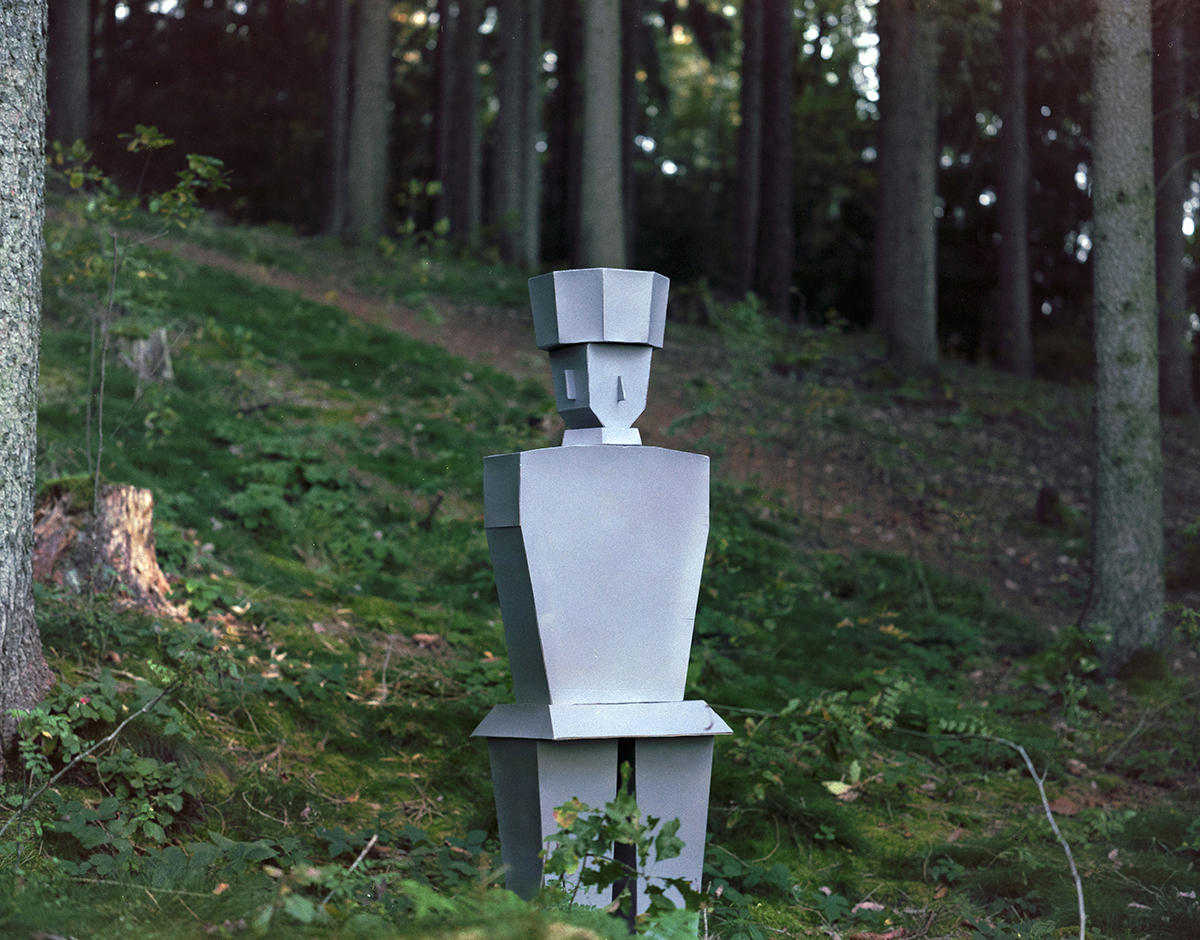 “Deconstructed Miner” in the hollowed out woods transformed by the historic mining near the histori mine “Engländerstollen”.
Analysis of a regional symbol, the miner. Since the first strike of silver about 1000 years ago, many minerals have been processed, until the industry wasn’t lucrative anymore by the 20th century. In the 50s, the communist regime Uranium was mined. Recently, lithium and cobalt have once again gained in importance.
In the 1930s, Nazi cultural politics re-invigorated the miner as cultural icon and quintessential man of nature, masculinity, occult spirituality, his life threatened daily in the dangerous work underground. This revisionist view was kept alive until recently, as right-wing extremism sweeps the region, for instance the right wing terror group NSU has roots in the Ore Mountains.
I have built the miner’s habit, a 3D model proxy, a blank surface for the pristine belief in an unadulterated but in fact “invented” tradition, easily deconstructed upon closer inspection, like the sculpture.
“Deconstructed Miner” in the hollowed out woods transformed by the historic mining near the histori mine “Engländerstollen”.
Analysis of a regional symbol, the miner. Since the first strike of silver about 1000 years ago, many minerals have been processed, until the industry wasn’t lucrative anymore by the 20th century. In the 50s, the communist regime Uranium was mined. Recently, lithium and cobalt have once again gained in importance.
In the 1930s, Nazi cultural politics re-invigorated the miner as cultural icon and quintessential man of nature, masculinity, occult spirituality, his life threatened daily in the dangerous work underground. This revisionist view was kept alive until recently, as right-wing extremism sweeps the region, for instance the right wing terror group NSU has roots in the Ore Mountains.
I have built the miner’s habit, a 3D model proxy, a blank surface for the pristine belief in an unadulterated but in fact “invented” tradition, easily deconstructed upon closer inspection, like the sculpture.
 Out of commission fence, leftover from communist regime, close to historic mining caverns near Freiberg.
Out of commission fence, leftover from communist regime, close to historic mining caverns near Freiberg.
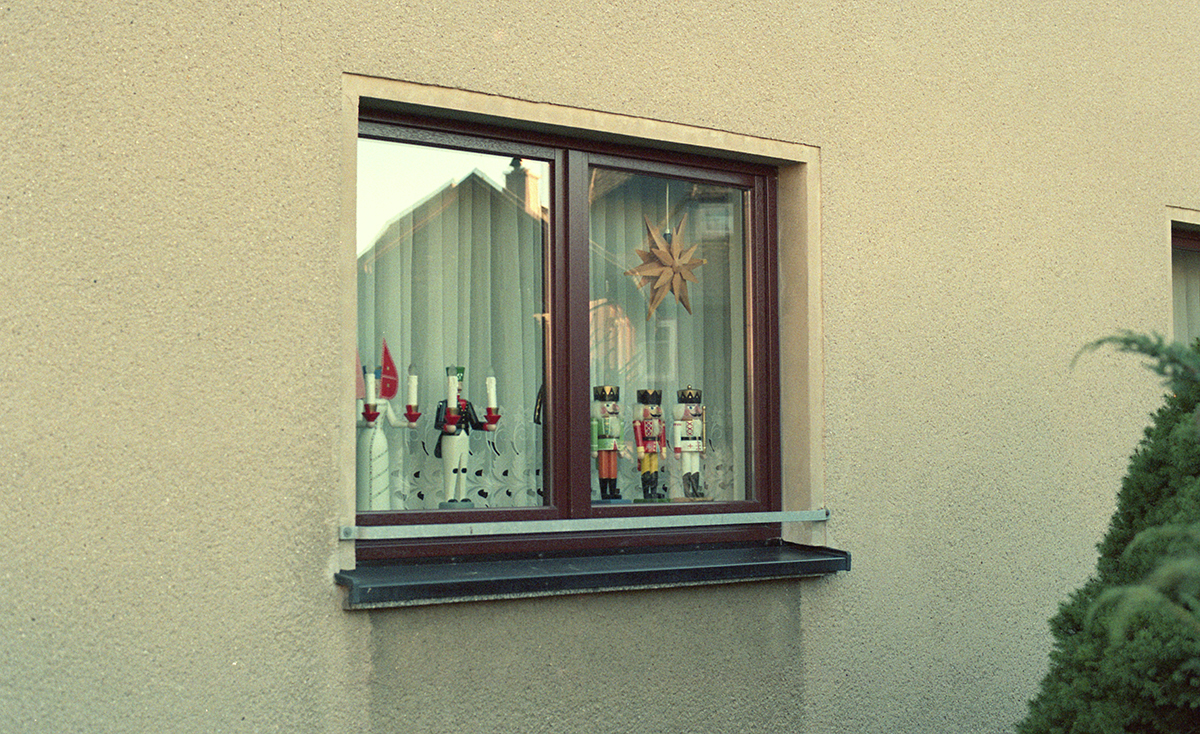 "Engel und Bergmann", Angel and Miner in the window, traditional figurines developed during the woodworking turn after the mining industry became obsolete. The number of male and female figurines symbolizes the gender of each child in the household.
"Engel und Bergmann", Angel and Miner in the window, traditional figurines developed during the woodworking turn after the mining industry became obsolete. The number of male and female figurines symbolizes the gender of each child in the household.
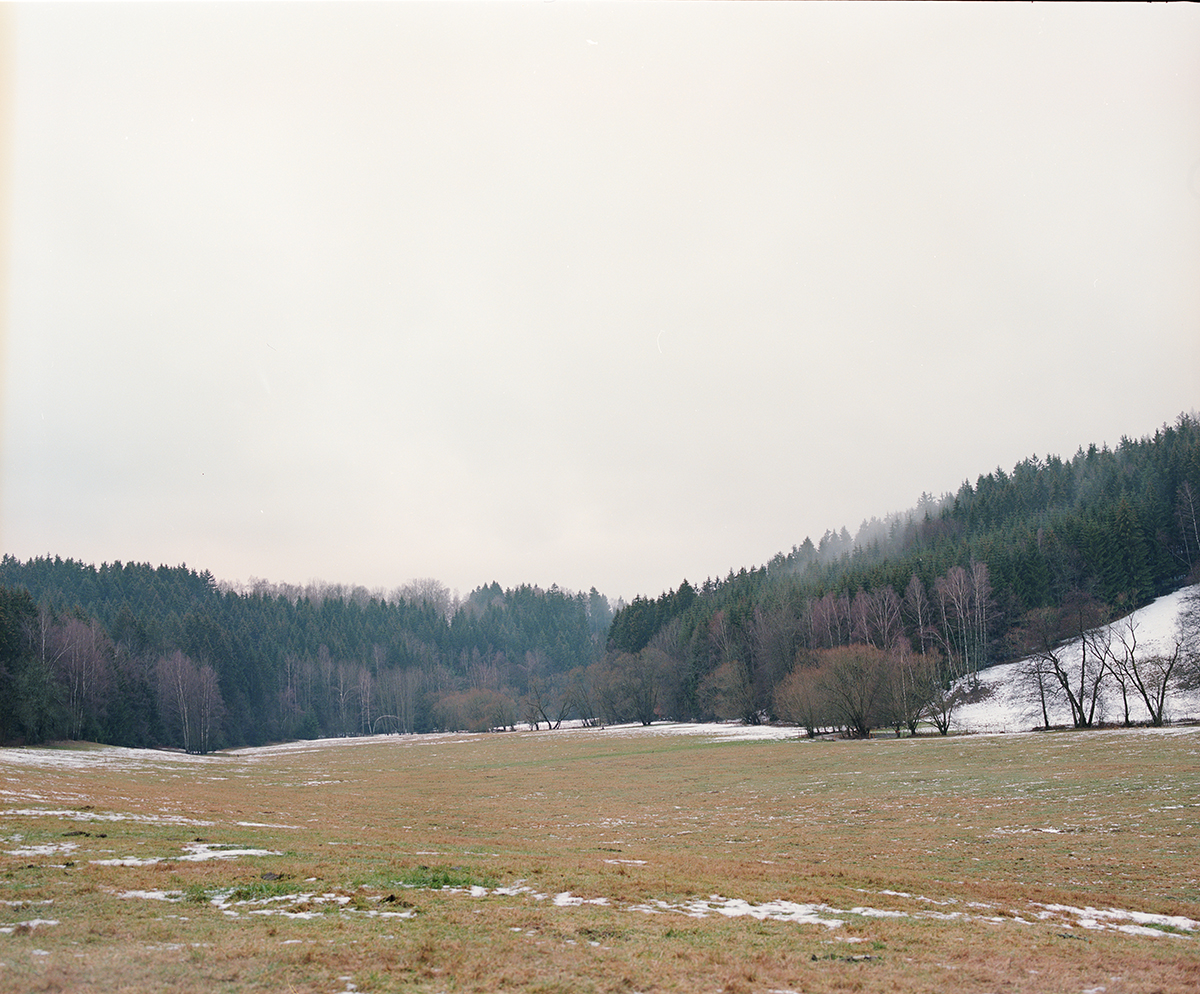 Former landscapes affected by the historic mining in the Ore Mountains. Hollowed out field and forest nearby Schwarzenberg.
Former landscapes affected by the historic mining in the Ore Mountains. Hollowed out field and forest nearby Schwarzenberg.
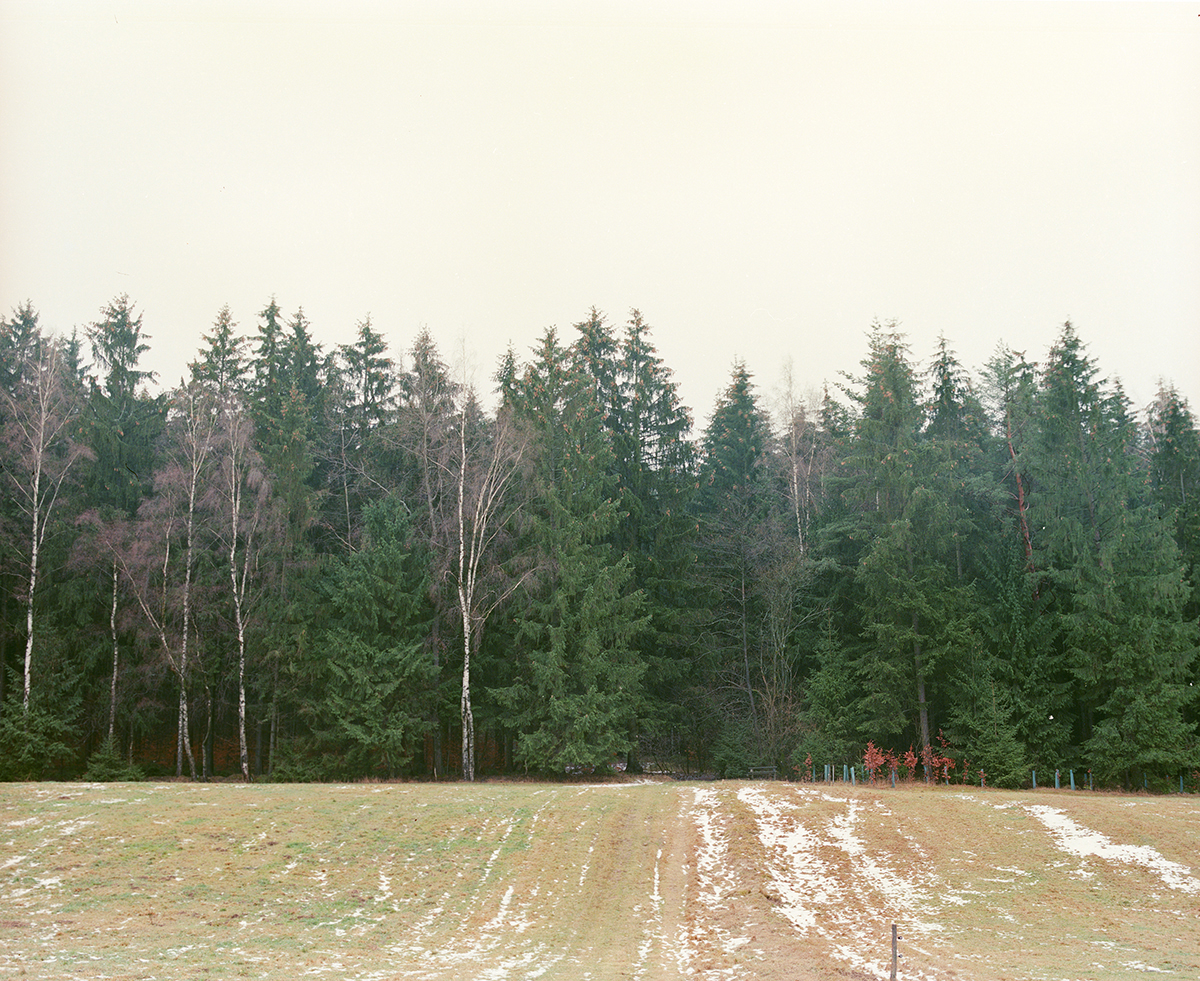 Landscapes affected by the historic mining in the Ore Mountains. Caverns under woods and field, close to adit hole of the "Grube Gottes Geschick” mine near Schwarzenberg.
Landscapes affected by the historic mining in the Ore Mountains. Caverns under woods and field, close to adit hole of the "Grube Gottes Geschick” mine near Schwarzenberg.
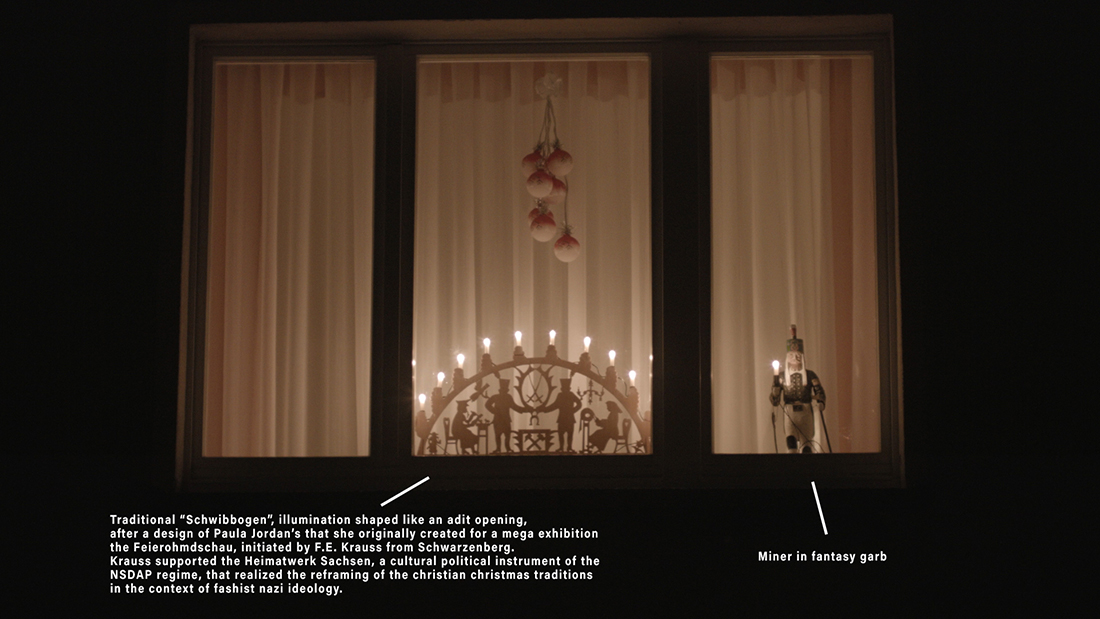
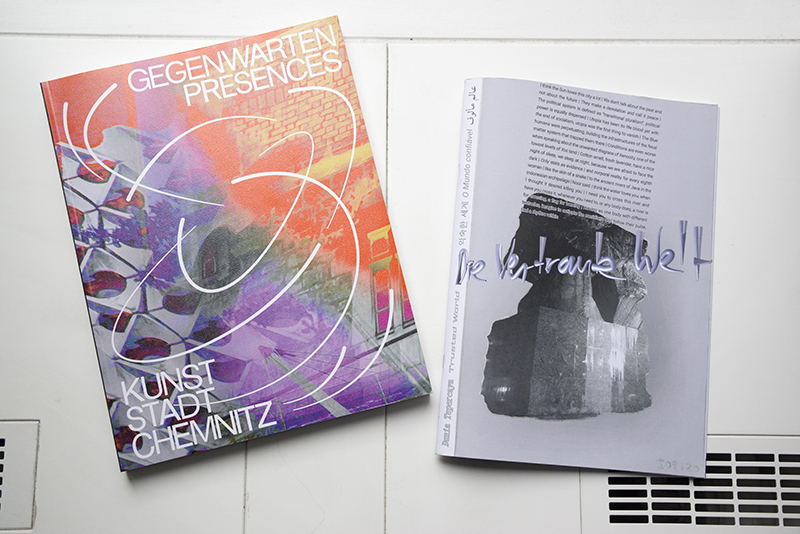
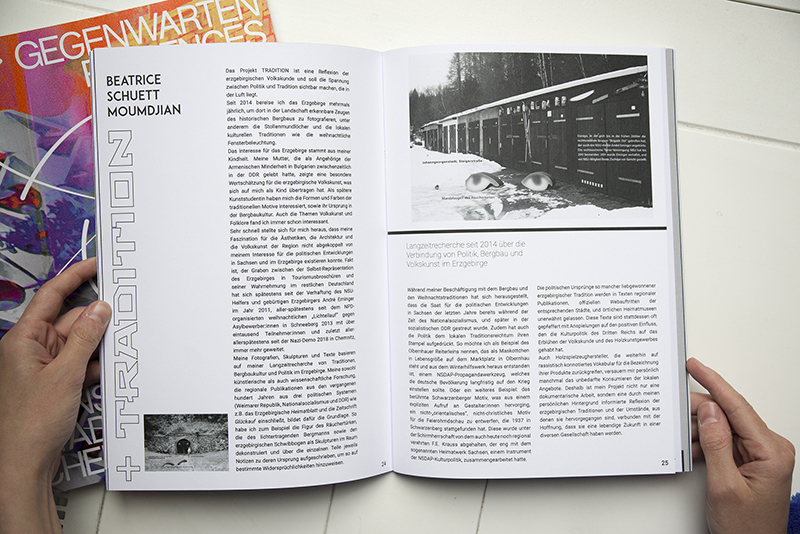
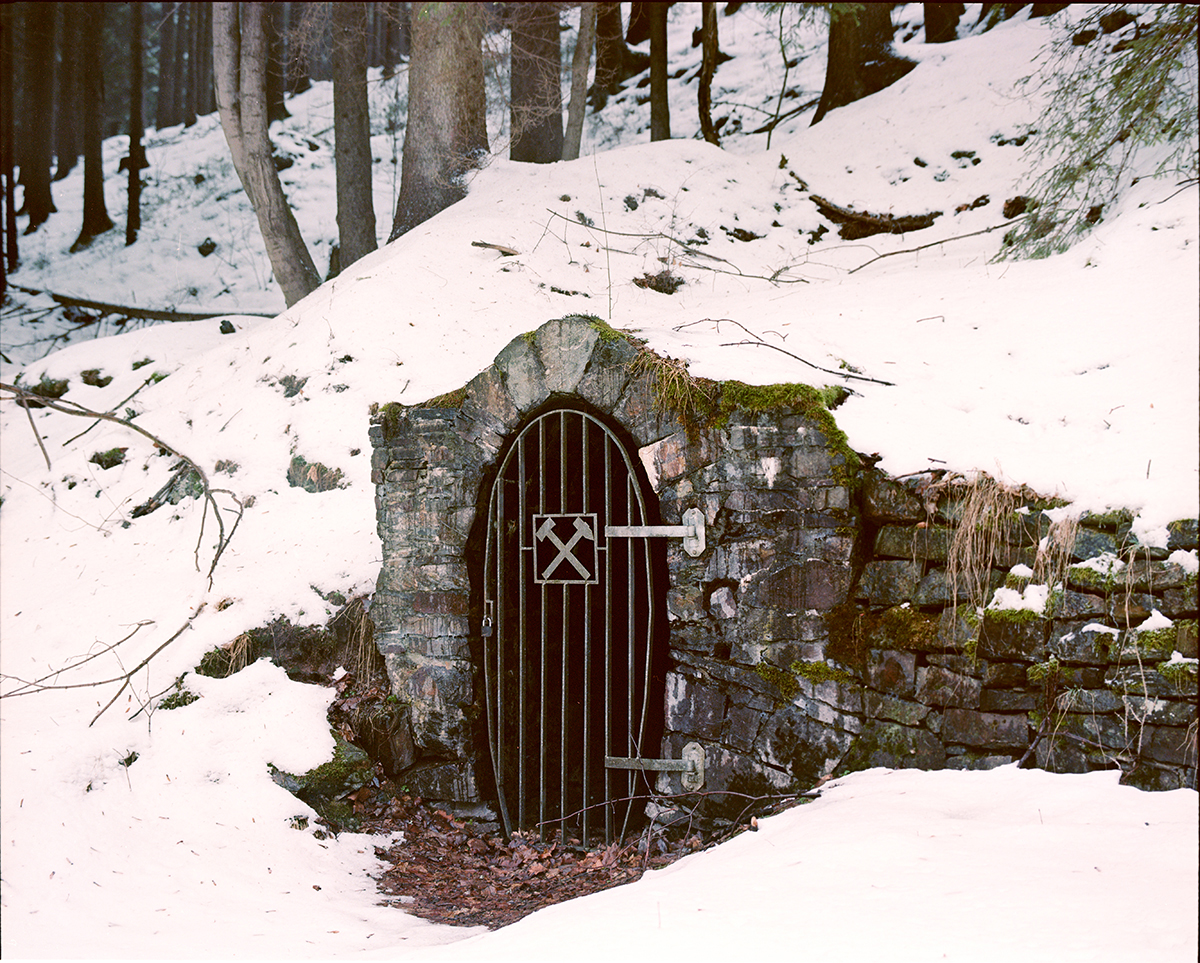 "Mundloch" (German for "mouth hole"), adit opening to the historic mine “Neu Freiberger Stollen”, near Johanngeorgenstadt.
"Mundloch" (German for "mouth hole"), adit opening to the historic mine “Neu Freiberger Stollen”, near Johanngeorgenstadt.
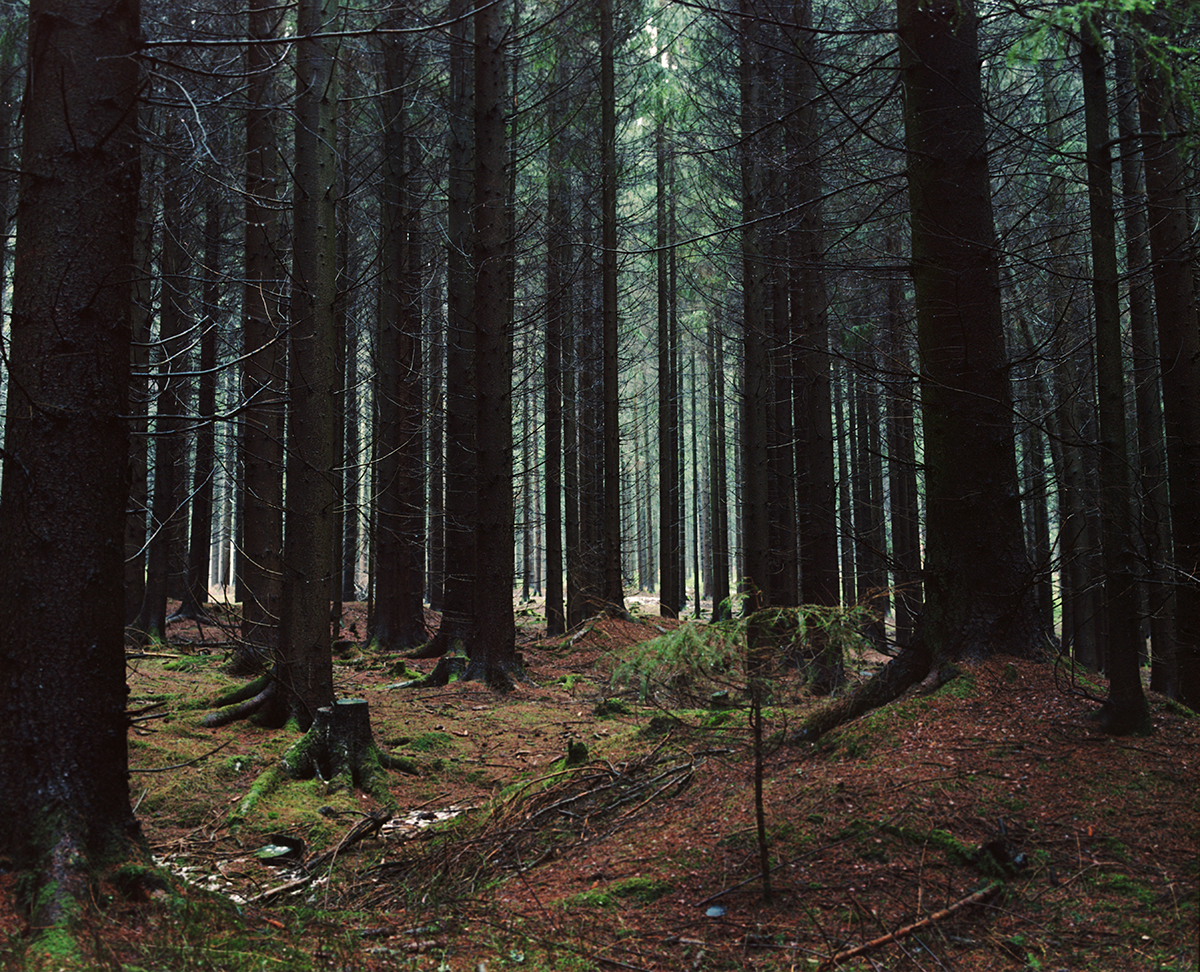 Artificial forest transformed by historic mining near adit opening “Grube Gottes Geschick”, Schwarzenberg. The woods in the entire region are nowadays artificially created to accommodate the woodworking (and toy) industry of the past 200 years and hollowed out with mines.
Artificial forest transformed by historic mining near adit opening “Grube Gottes Geschick”, Schwarzenberg. The woods in the entire region are nowadays artificially created to accommodate the woodworking (and toy) industry of the past 200 years and hollowed out with mines.
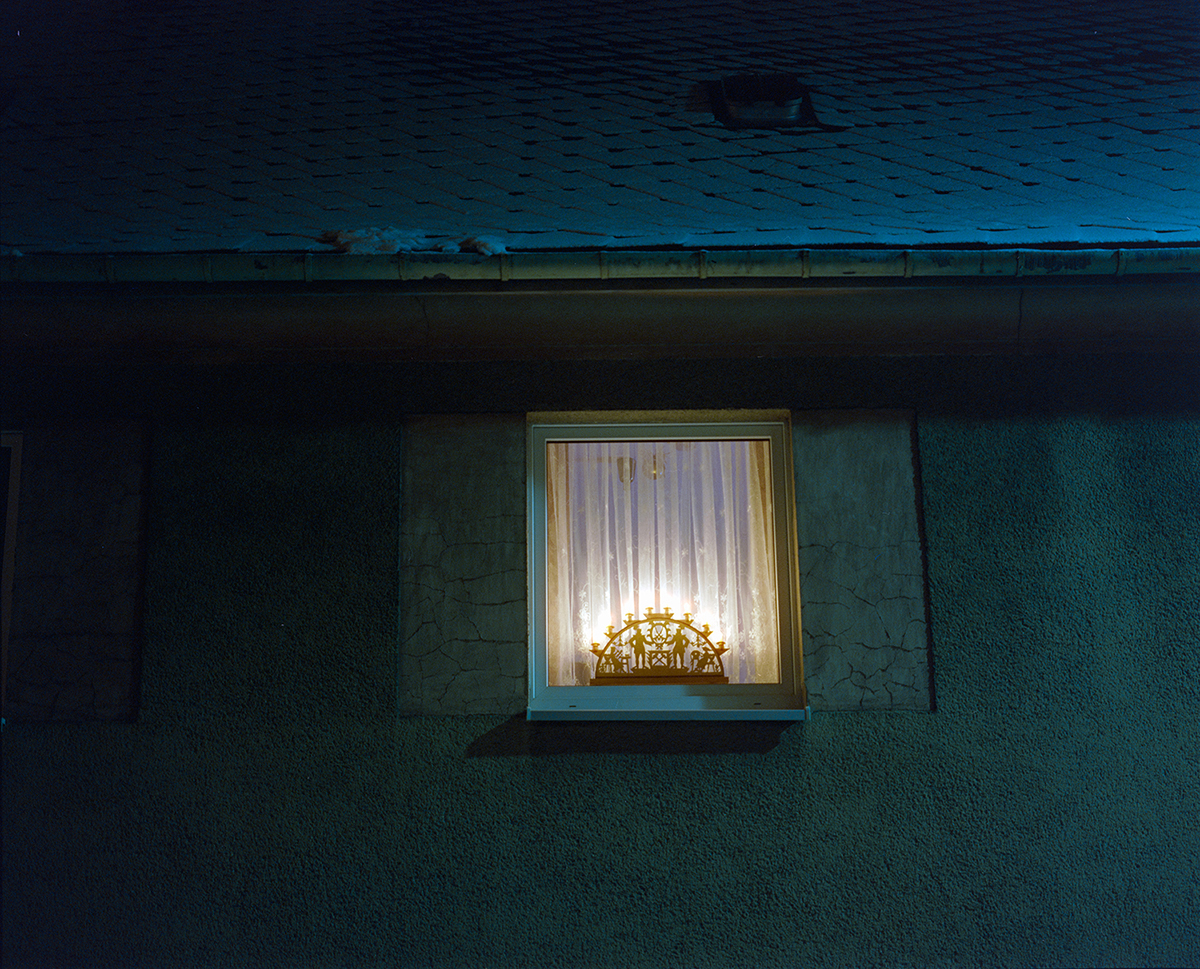 Mining and christianity have contributed to the various traditions present in the region. Over time the industry turned towards wood processing as well as artisanal decoration making; examples are nutcrackers; christmas pyramids and other typical figures of the region. These figures and objects are often illuminated, and populate every single window in the Ore Mountains in the time frame from about November and February every year. The most popular candle holder is the Schwibbogen, is in the shape of the adit opening, or according to other sources, a symbol for heaven. Folklorist studies have established that the object circulated in the 18th century between mining crews as custommade gifts, usually depicting miners and christian symbols like Adam and Eve. It 1937 it was adapted to depict strictly anti-"oriental" (oriental meaning christian) imagery, in the context of a huge Nazi-party powered exhibition called Feierohmdschau, and since then was manufactured as a mass product and exported to the entire world. The 1937 design that was supposed to depict nationalistic pride is today still the most popular one.
Mining and christianity have contributed to the various traditions present in the region. Over time the industry turned towards wood processing as well as artisanal decoration making; examples are nutcrackers; christmas pyramids and other typical figures of the region. These figures and objects are often illuminated, and populate every single window in the Ore Mountains in the time frame from about November and February every year. The most popular candle holder is the Schwibbogen, is in the shape of the adit opening, or according to other sources, a symbol for heaven. Folklorist studies have established that the object circulated in the 18th century between mining crews as custommade gifts, usually depicting miners and christian symbols like Adam and Eve. It 1937 it was adapted to depict strictly anti-"oriental" (oriental meaning christian) imagery, in the context of a huge Nazi-party powered exhibition called Feierohmdschau, and since then was manufactured as a mass product and exported to the entire world. The 1937 design that was supposed to depict nationalistic pride is today still the most popular one.

.jpg)

 Johangeorgenstadt, 2019: Record holder biggest “Schwibbogen” in the world, built 2012. The motive was designed for the 1937 mega-exhibition“Feierohmdschau”, initiated in collaboration with the cultural-political national-socialist body“Heimatwerk Sachsen” by Friedrich Emil Krauss in Schwarzenberg, who to this day is a revered person locally. This was done in order to boost the wood art industry. Until then only a couple dozen Schwibbögen with christian motives had been made and circulated as gifts among miners, largely restricted to Johanngeorgenstadt, since the early 18th century. Since 1937 it has become a mass product and world wide export. The desired motive was explicitly described in an open call as “anti-oriental” and anti-Christian and was intended to transport so-called German virtues, symbolized in Erzgebirge traditions such as mining, propagandistically into the world. The winning design was created by Paula Jordan.
Johangeorgenstadt, 2019: Record holder biggest “Schwibbogen” in the world, built 2012. The motive was designed for the 1937 mega-exhibition“Feierohmdschau”, initiated in collaboration with the cultural-political national-socialist body“Heimatwerk Sachsen” by Friedrich Emil Krauss in Schwarzenberg, who to this day is a revered person locally. This was done in order to boost the wood art industry. Until then only a couple dozen Schwibbögen with christian motives had been made and circulated as gifts among miners, largely restricted to Johanngeorgenstadt, since the early 18th century. Since 1937 it has become a mass product and world wide export. The desired motive was explicitly described in an open call as “anti-oriental” and anti-Christian and was intended to transport so-called German virtues, symbolized in Erzgebirge traditions such as mining, propagandistically into the world. The winning design was created by Paula Jordan.
 Mundloch (German for "mouth hole"), adit opening to the historic mine near Schwarzenberg.
Mundloch (German for "mouth hole"), adit opening to the historic mine near Schwarzenberg.
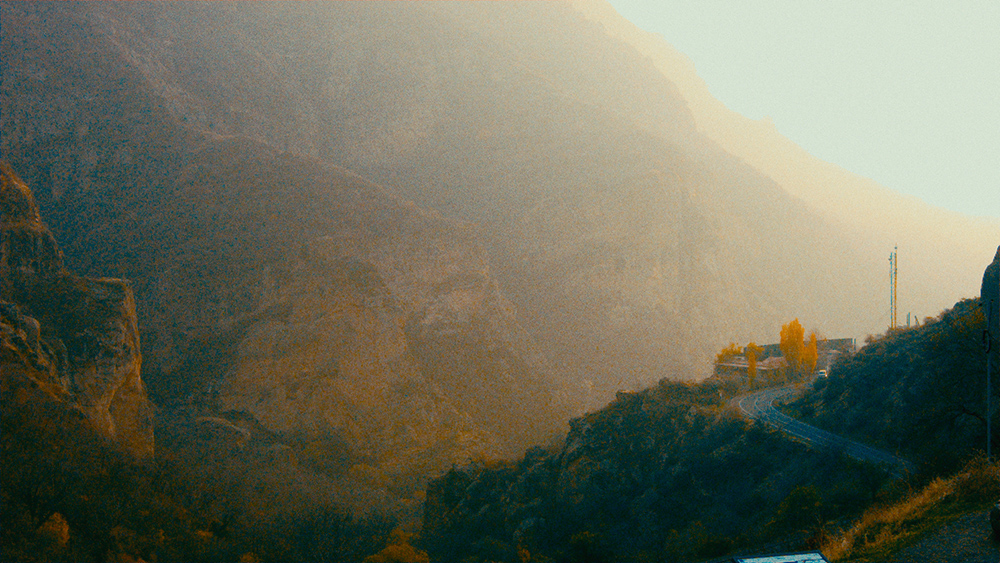 EN:
Video still. Mountaineous region near Yerevan. In the project "Kopie des Erzgebirges im sogenannten Fernen Osten / Copy of the Ore Mountains in the so-called Far East" (wt), I relate this landscape to the Ore Mountains.
DE:
Videostill. Gebirge nahe Yerevan. In dem Projekt "Kopie des Erzgebirges im sogenannten Fernen Osten" (AT) beziehe ich diese Landschaft auf das Erzgebirge.
EN:
Video still. Mountaineous region near Yerevan. In the project "Kopie des Erzgebirges im sogenannten Fernen Osten / Copy of the Ore Mountains in the so-called Far East" (wt), I relate this landscape to the Ore Mountains.
DE:
Videostill. Gebirge nahe Yerevan. In dem Projekt "Kopie des Erzgebirges im sogenannten Fernen Osten" (AT) beziehe ich diese Landschaft auf das Erzgebirge.
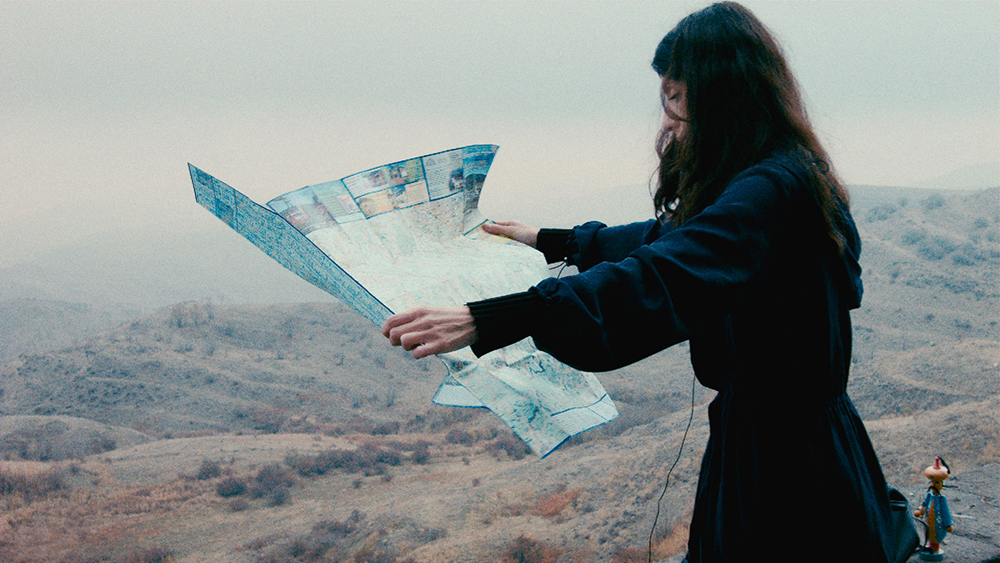 EN:
Video still. Mountaineous region near Yerevan. My character, Valentina Nergararian, an Armenian real estate developer and creative partner in a fictitious cooperation between the Ore Mountains and Yerevan, looks at an Ore Mountains map. From the project "Kopie des Erzgebirges im sogenannten Fernen Osten / Copy of the Ore Mountains in the so-called Far East" (wt).
DE
Video still. Gebirge in der Nähe von Yerevan. Meine Figur, Valentina Nergararian, eine armenische Immobilienentwicklerin und kreative Partnerin in einer fiktiven Kooperation zwischen dem Erzgebirge und Eriwan, schaut auf eine Erzgebirgskarte. Aus dem Projekt "Kopie des Erzgebirges im sogenannten Fernen Osten" (AT).
EN:
Video still. Mountaineous region near Yerevan. My character, Valentina Nergararian, an Armenian real estate developer and creative partner in a fictitious cooperation between the Ore Mountains and Yerevan, looks at an Ore Mountains map. From the project "Kopie des Erzgebirges im sogenannten Fernen Osten / Copy of the Ore Mountains in the so-called Far East" (wt).
DE
Video still. Gebirge in der Nähe von Yerevan. Meine Figur, Valentina Nergararian, eine armenische Immobilienentwicklerin und kreative Partnerin in einer fiktiven Kooperation zwischen dem Erzgebirge und Eriwan, schaut auf eine Erzgebirgskarte. Aus dem Projekt "Kopie des Erzgebirges im sogenannten Fernen Osten" (AT).
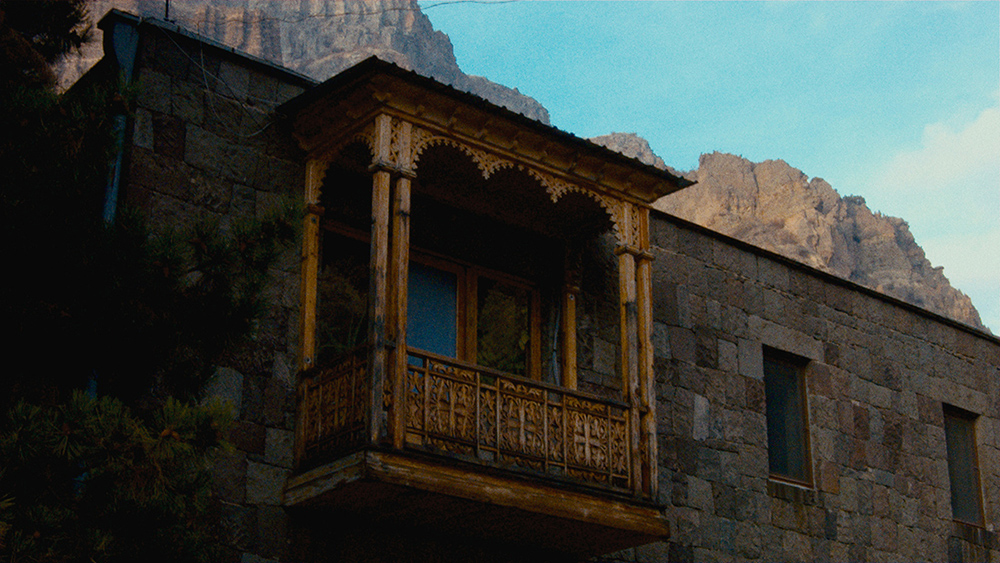 EN:
Video still. Traditional wood carving near Yerevan, at Geghard monastery that was rebuilt in the 12th century. In the project "Kopie des Erzgebirges im sogenannten Fernen Osten / Copy of the Ore Mountains in the so-called Far East" (wt), I relate this technique and recurring symbols to Erzgebirge wood carving.
DE:
Videostill. Traditionelle Holzschnitzerei bei Yerevan im Geghard-Kloster, das im 12. Jahrhundert wieder aufgebaut wurde. In dem Projekt "Kopie des Erzgebirges im sogenannten Fernen Osten" (AT) beziehe ich diese Technik und wiederkehrende Symbole auf die erzgebirgische Holzschnitzerei.
EN:
Video still. Traditional wood carving near Yerevan, at Geghard monastery that was rebuilt in the 12th century. In the project "Kopie des Erzgebirges im sogenannten Fernen Osten / Copy of the Ore Mountains in the so-called Far East" (wt), I relate this technique and recurring symbols to Erzgebirge wood carving.
DE:
Videostill. Traditionelle Holzschnitzerei bei Yerevan im Geghard-Kloster, das im 12. Jahrhundert wieder aufgebaut wurde. In dem Projekt "Kopie des Erzgebirges im sogenannten Fernen Osten" (AT) beziehe ich diese Technik und wiederkehrende Symbole auf die erzgebirgische Holzschnitzerei.
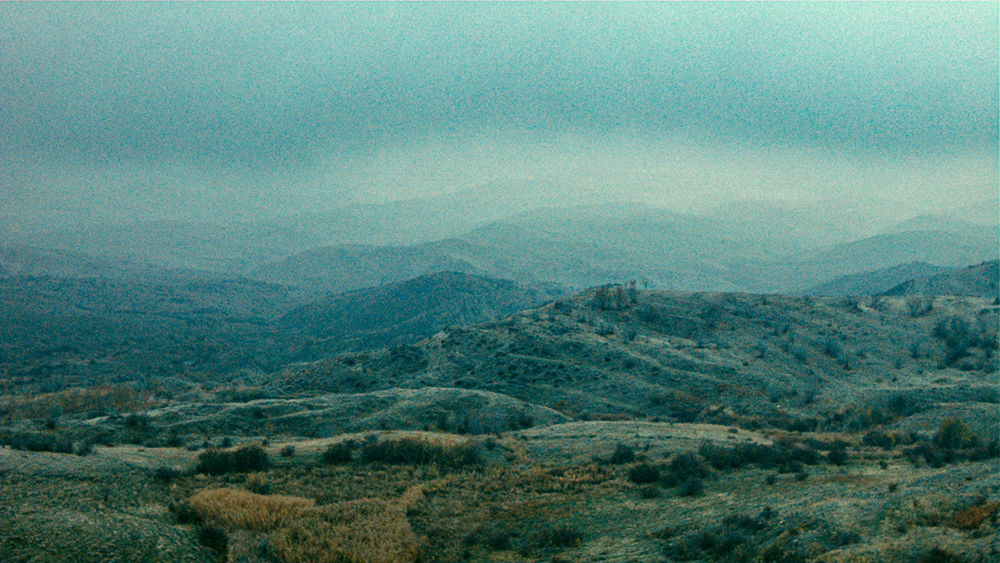 EN:
Video still. Mountaineous region near Yerevan, a possible future site of the fictitious Ore Mountains theme park in Yerevan. From the project "Copy of the Ore Mountains in the so-called Far East / Kopie des Erzgebirges im sogenannten Fernen Osten" (wt).
DE:
Video still. Gebirgsregion in der Nähe von Yerevan, möglicher zukünftiger Standort des fiktiven Themenparks Erzgebirge in Yerevan. Aus dem Projekt "Kopie des Erzgebirges im sogenannten Fernen Osten" (AT).
EN:
Video still. Mountaineous region near Yerevan, a possible future site of the fictitious Ore Mountains theme park in Yerevan. From the project "Copy of the Ore Mountains in the so-called Far East / Kopie des Erzgebirges im sogenannten Fernen Osten" (wt).
DE:
Video still. Gebirgsregion in der Nähe von Yerevan, möglicher zukünftiger Standort des fiktiven Themenparks Erzgebirge in Yerevan. Aus dem Projekt "Kopie des Erzgebirges im sogenannten Fernen Osten" (AT).
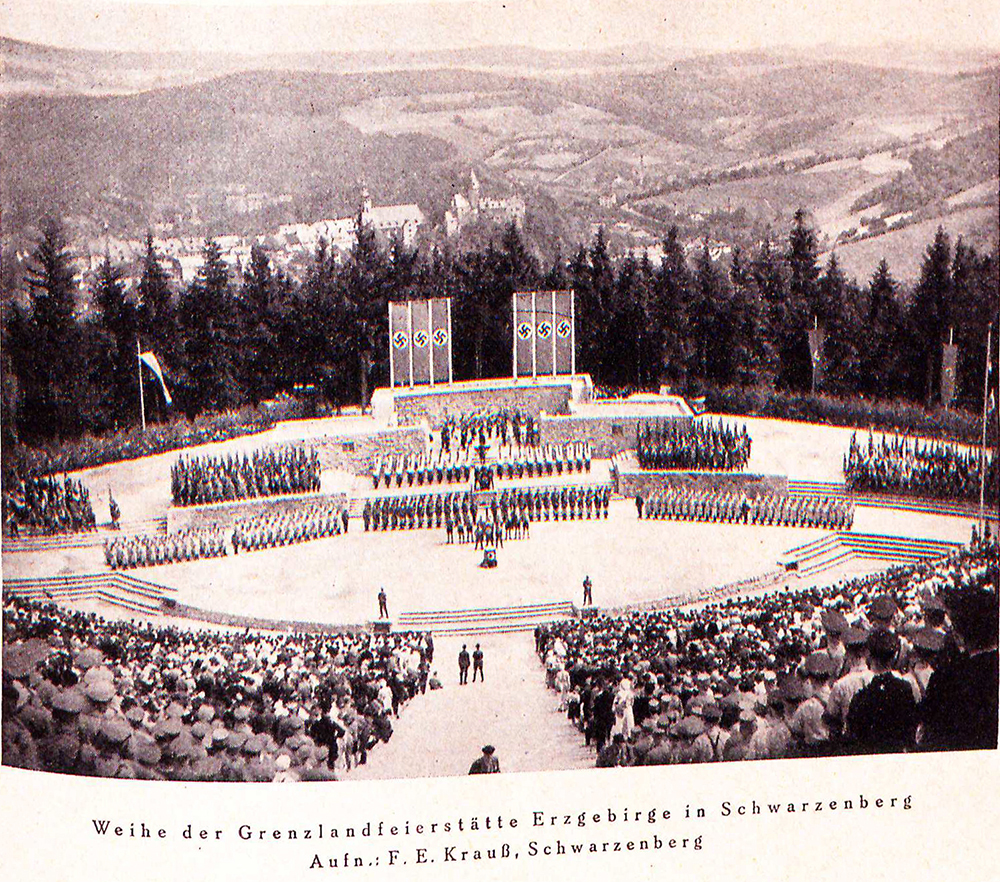 Scan. Image of the inauguration by Adolf Hitler of the Forest Stage in Schwarzenberg. Scanned by my from regional periodic journal Glückauf No. 58, 1938, photo by F.E. Krauss, NS-functionary in the Erzgebirge, also innovator and industrialist; to this day valued in parts of the local Erzgebirge population..
Scan. Image of the inauguration by Adolf Hitler of the Forest Stage in Schwarzenberg. Scanned by my from regional periodic journal Glückauf No. 58, 1938, photo by F.E. Krauss, NS-functionary in the Erzgebirge, also innovator and industrialist; to this day valued in parts of the local Erzgebirge population..
.jpg) Scan. Schwibbogen from 1740, but this is a recent discovery from 2004. It was still believed to be from 1778 in this publication here. Schwibbögen were a regional handmade handproduced object, circulating between mining groups in the Johanngeorgenstadt area, usually with Christian motives. In the 1930s, the NS cultural politics, heavily supported by regional figures, seized the motif of this candle holder and expanded it into a traditionalist symbol with nationalist connotations. From 1937 it became a mass produced export. Scanned by me, from Erzgebirgische Schwibboegen, Christian Teller. Folklorezentrum Erzgebirge/Vogtland beim Bezirkskabinett fuer Kulturarbeit. 1989
Scan. Schwibbogen from 1740, but this is a recent discovery from 2004. It was still believed to be from 1778 in this publication here. Schwibbögen were a regional handmade handproduced object, circulating between mining groups in the Johanngeorgenstadt area, usually with Christian motives. In the 1930s, the NS cultural politics, heavily supported by regional figures, seized the motif of this candle holder and expanded it into a traditionalist symbol with nationalist connotations. From 1937 it became a mass produced export. Scanned by me, from Erzgebirgische Schwibboegen, Christian Teller. Folklorezentrum Erzgebirge/Vogtland beim Bezirkskabinett fuer Kulturarbeit. 1989
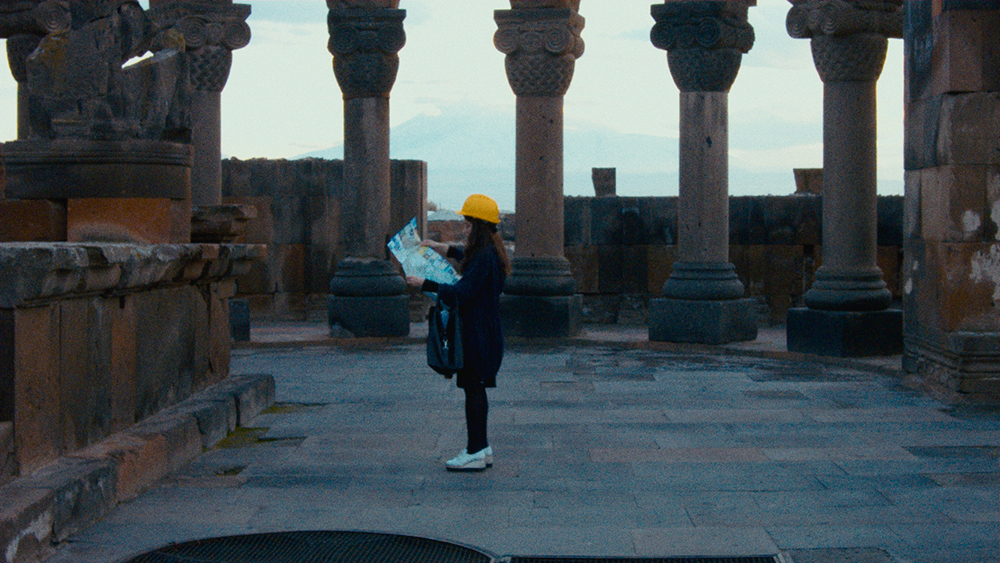 EN:
Video still. Zvartnots cathedral near Yerevan, in front of the Mount Ararat. My character, Valentina Nergararian, an Armenian real estate developer and creative partner in a fictitious cooperation between the Ore Mountains and Yerevan, holds a map of the Ore Mountains in the ruins of the cathedral to orient herself and the coming Ore Mountains theme park. From the project "Kopie des Erzgebirges im sogenannten Fernen Osten / Copy of the Ore Mountains in the so-called Far East" (wt).
DE
Video still. Die Kathedrale von Zvartnots in der Nähe von Yerevan, vor dem Berg Ararat. Meine Figur, Valentina Nergararian, eine armenische Immobilienentwicklerin und kreative Partnerin in einer fiktiven Kooperation zwischen dem Erzgebirge und Yerevan, hält in den Ruinen der Kathedrale eine Karte des Erzgebirges in der Hand, um sich und den kommenden erzgebirgischen Themenpark zu orientieren. Aus dem Projekt "Kopie des Erzgebirges im sogenannten Fernen Osten" (AT).
EN:
Video still. Zvartnots cathedral near Yerevan, in front of the Mount Ararat. My character, Valentina Nergararian, an Armenian real estate developer and creative partner in a fictitious cooperation between the Ore Mountains and Yerevan, holds a map of the Ore Mountains in the ruins of the cathedral to orient herself and the coming Ore Mountains theme park. From the project "Kopie des Erzgebirges im sogenannten Fernen Osten / Copy of the Ore Mountains in the so-called Far East" (wt).
DE
Video still. Die Kathedrale von Zvartnots in der Nähe von Yerevan, vor dem Berg Ararat. Meine Figur, Valentina Nergararian, eine armenische Immobilienentwicklerin und kreative Partnerin in einer fiktiven Kooperation zwischen dem Erzgebirge und Yerevan, hält in den Ruinen der Kathedrale eine Karte des Erzgebirges in der Hand, um sich und den kommenden erzgebirgischen Themenpark zu orientieren. Aus dem Projekt "Kopie des Erzgebirges im sogenannten Fernen Osten" (AT).
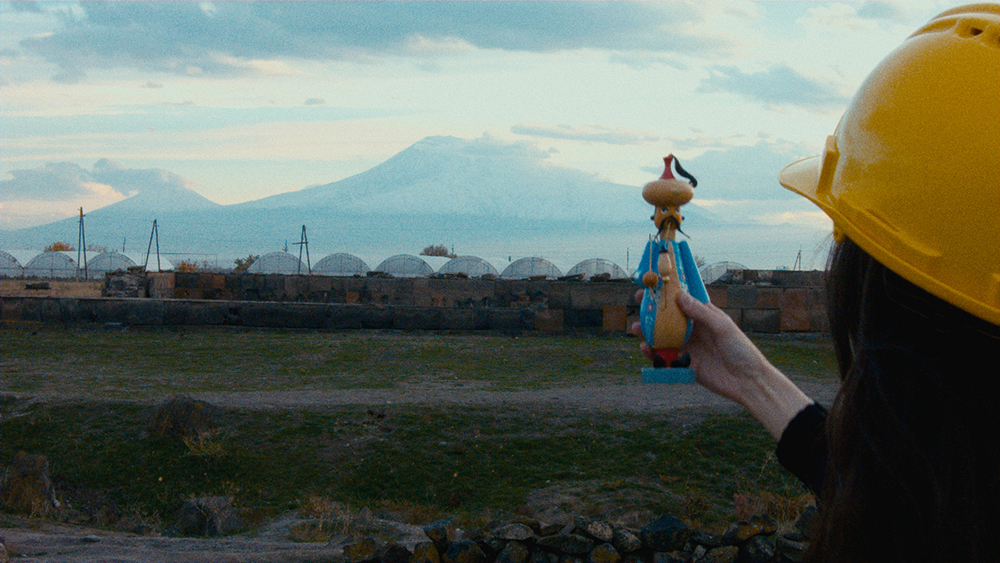 EN:
Video still. Zvartnots cathedral near Yerevan, in front of the Mount Ararat. My character, Valentina Nergararian, an Armenian real estate developer and creative partner in a fictitious cooperation between the Ore Mountains and Yerevan, talks about the traditional Ore Mountain orientalist figure, the Ottoman Turk. Her team wants to place him as an oversized ride and attraction in the coming Ore Mountains theme park. From the project "Kopie des Erzgebirges im sogenannten Fernen Osten / Copy of the Ore Mountains in the so-called Far East" (wt).
DE:
Video still. Die Kathedrale von Zvartnots in der Nähe von Yerevan, vor dem Berg Ararat. Meine Figur, Valentina Nergararian, eine armenische Immobilienentwicklerin und kreative Partnerin in einer fiktiven Kooperation zwischen dem Erzgebirge und Eriwan, spricht über die traditionelle erzgebirgische orientalistische Figur, den osmanischen "Räuchertürken". Ihr Team will ihn als überdimensionales Fahrgeschäft und Attraktion im kommenden erzgebirgischen Themenpark platzieren. Aus dem Projekt "Kopie des Erzgebirges im sogenannten Fernen Osten" (AT).
EN:
Video still. Zvartnots cathedral near Yerevan, in front of the Mount Ararat. My character, Valentina Nergararian, an Armenian real estate developer and creative partner in a fictitious cooperation between the Ore Mountains and Yerevan, talks about the traditional Ore Mountain orientalist figure, the Ottoman Turk. Her team wants to place him as an oversized ride and attraction in the coming Ore Mountains theme park. From the project "Kopie des Erzgebirges im sogenannten Fernen Osten / Copy of the Ore Mountains in the so-called Far East" (wt).
DE:
Video still. Die Kathedrale von Zvartnots in der Nähe von Yerevan, vor dem Berg Ararat. Meine Figur, Valentina Nergararian, eine armenische Immobilienentwicklerin und kreative Partnerin in einer fiktiven Kooperation zwischen dem Erzgebirge und Eriwan, spricht über die traditionelle erzgebirgische orientalistische Figur, den osmanischen "Räuchertürken". Ihr Team will ihn als überdimensionales Fahrgeschäft und Attraktion im kommenden erzgebirgischen Themenpark platzieren. Aus dem Projekt "Kopie des Erzgebirges im sogenannten Fernen Osten" (AT).
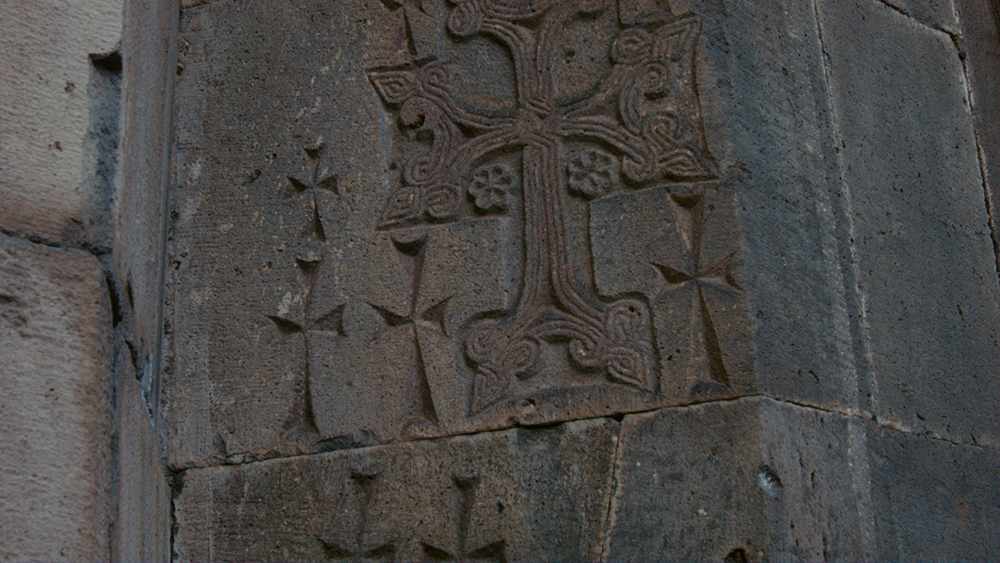 EN:
Video still. Traditional stone chiseling near Yerevan, at Geghard monastery that was rebuilt in the 12th century. In the project "Kopie des Erzgebirges im sogenannten Fernen Osten / Copy of the Ore Mountains in the so-called Far East" (wt), I relate this technique and recurring symbols to Erzgebirge wood carving.
DE:
Videostill. Traditionelle Steinmeisselei bei Yerevan im Geghard-Kloster, das im 12. Jahrhundert wieder aufgebaut wurde. In dem Projekt "Kopie des Erzgebirges im sogenannten Fernen Osten" (AT) beziehe ich diese Technik und wiederkehrende Symbole auf die erzgebirgische Holzschnitzerei.
EN:
Video still. Traditional stone chiseling near Yerevan, at Geghard monastery that was rebuilt in the 12th century. In the project "Kopie des Erzgebirges im sogenannten Fernen Osten / Copy of the Ore Mountains in the so-called Far East" (wt), I relate this technique and recurring symbols to Erzgebirge wood carving.
DE:
Videostill. Traditionelle Steinmeisselei bei Yerevan im Geghard-Kloster, das im 12. Jahrhundert wieder aufgebaut wurde. In dem Projekt "Kopie des Erzgebirges im sogenannten Fernen Osten" (AT) beziehe ich diese Technik und wiederkehrende Symbole auf die erzgebirgische Holzschnitzerei.
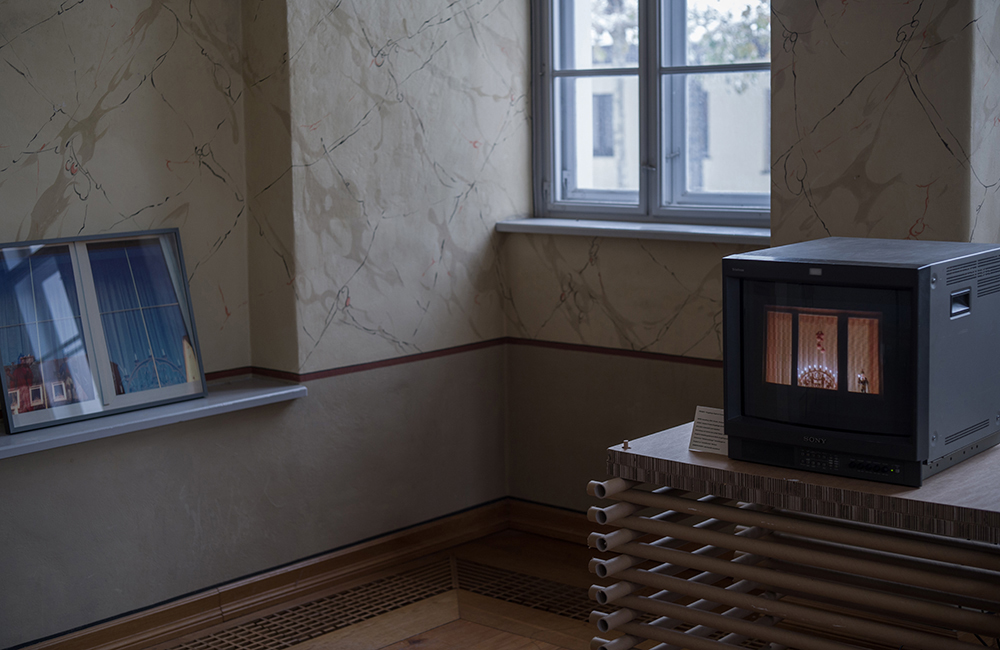 Installation view in 'ost in space' exhibition at Schmeilhaus, Erzgebirge, DE, 2023
Installation view in 'ost in space' exhibition at Schmeilhaus, Erzgebirge, DE, 2023
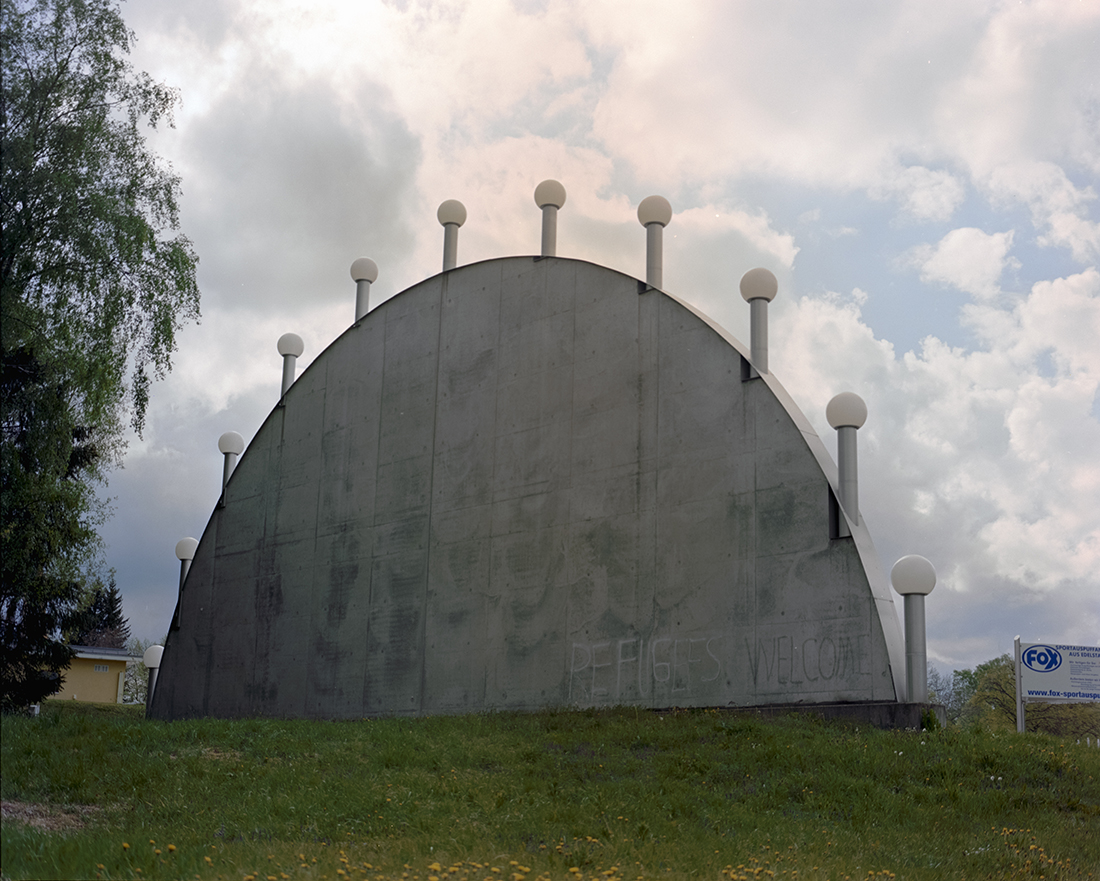
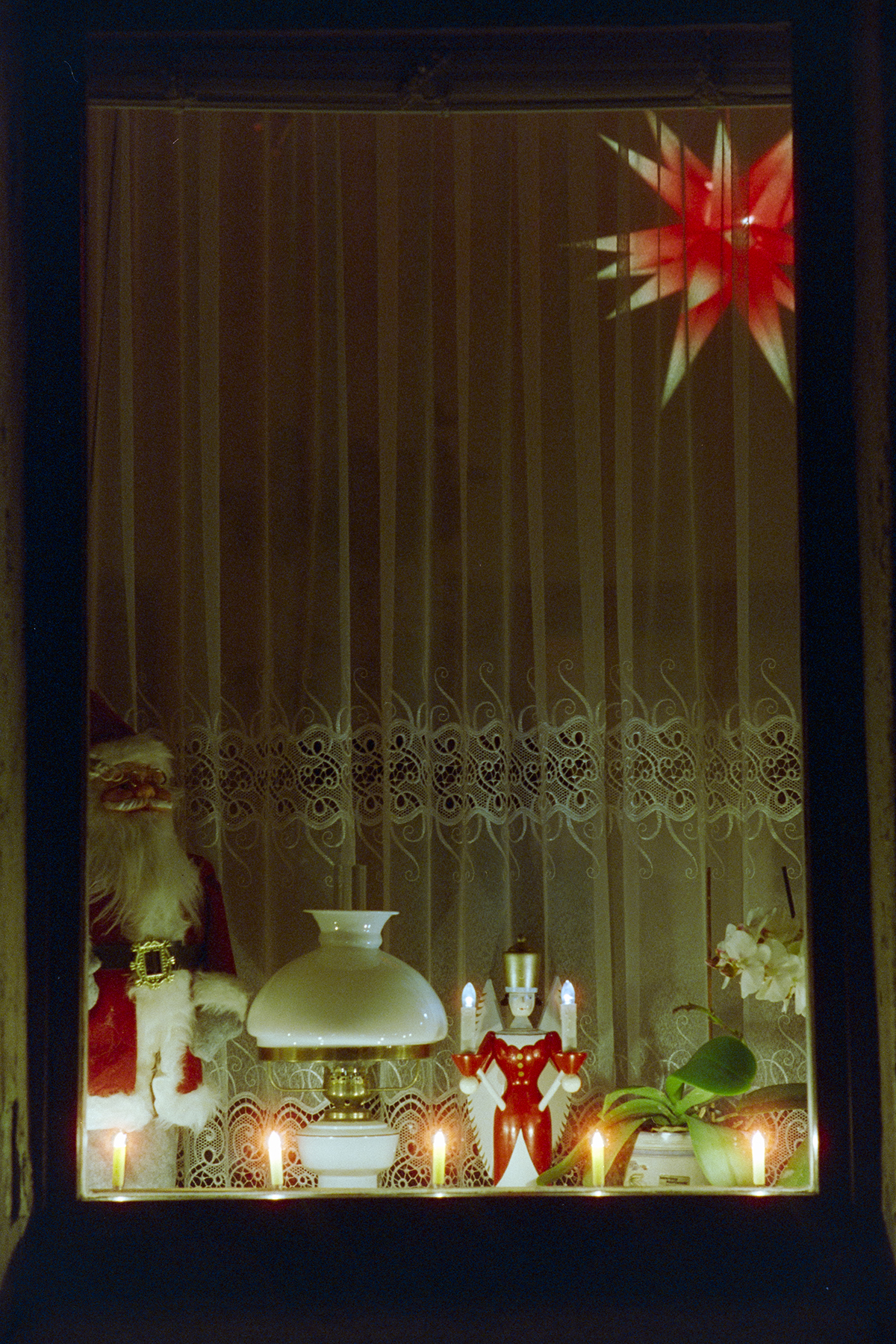
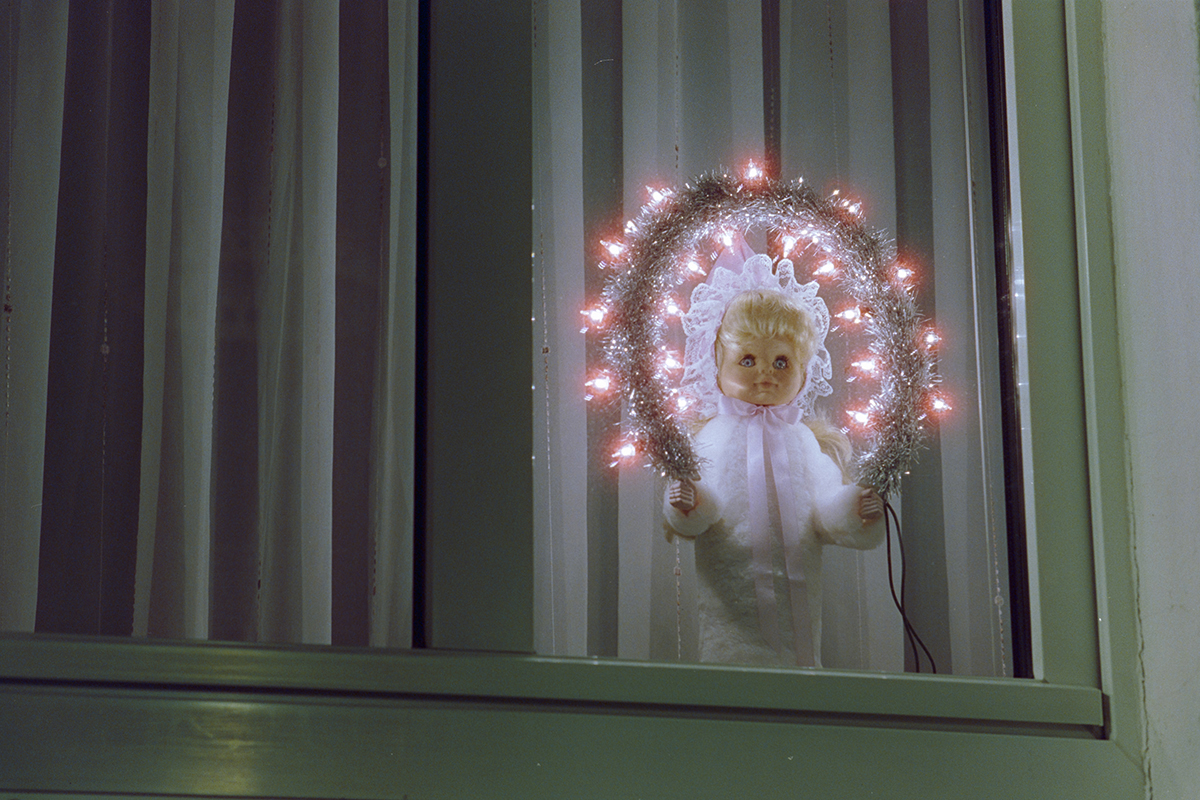 Ongoing cataloguing and classification of decorations and illuminated windows in the Ore Mountains.
Ongoing cataloguing and classification of decorations and illuminated windows in the Ore Mountains.
.jpg) Scan. "Smokerturk", Räuchertürke. Regional figure of a steretoypically dressed and designed Ottoman Turk that is used as an incense vessel influenced by Austrian orientalism, pictorials of which traveled through Czechoslovakia to the Ore Mountains in the 18th Century. Other Räuchermännchen, Smoker figures are usually regional characters like hunters and rangers. Scanned by me, Erzgebirgische Räuchermänner, Hellmut Bilz. Folklorezentrum Erzgebirge/Vogtland beim Bezirkskabinett fuer Kulturarbeit. 1987
“In the long section of a Räuchermann / smoker “Turk”, the hollow upturned upper body as incineration space and the perforated mouth opening as smoke outlet is visible.”
Scan. "Smokerturk", Räuchertürke. Regional figure of a steretoypically dressed and designed Ottoman Turk that is used as an incense vessel influenced by Austrian orientalism, pictorials of which traveled through Czechoslovakia to the Ore Mountains in the 18th Century. Other Räuchermännchen, Smoker figures are usually regional characters like hunters and rangers. Scanned by me, Erzgebirgische Räuchermänner, Hellmut Bilz. Folklorezentrum Erzgebirge/Vogtland beim Bezirkskabinett fuer Kulturarbeit. 1987
“In the long section of a Räuchermann / smoker “Turk”, the hollow upturned upper body as incineration space and the perforated mouth opening as smoke outlet is visible.”

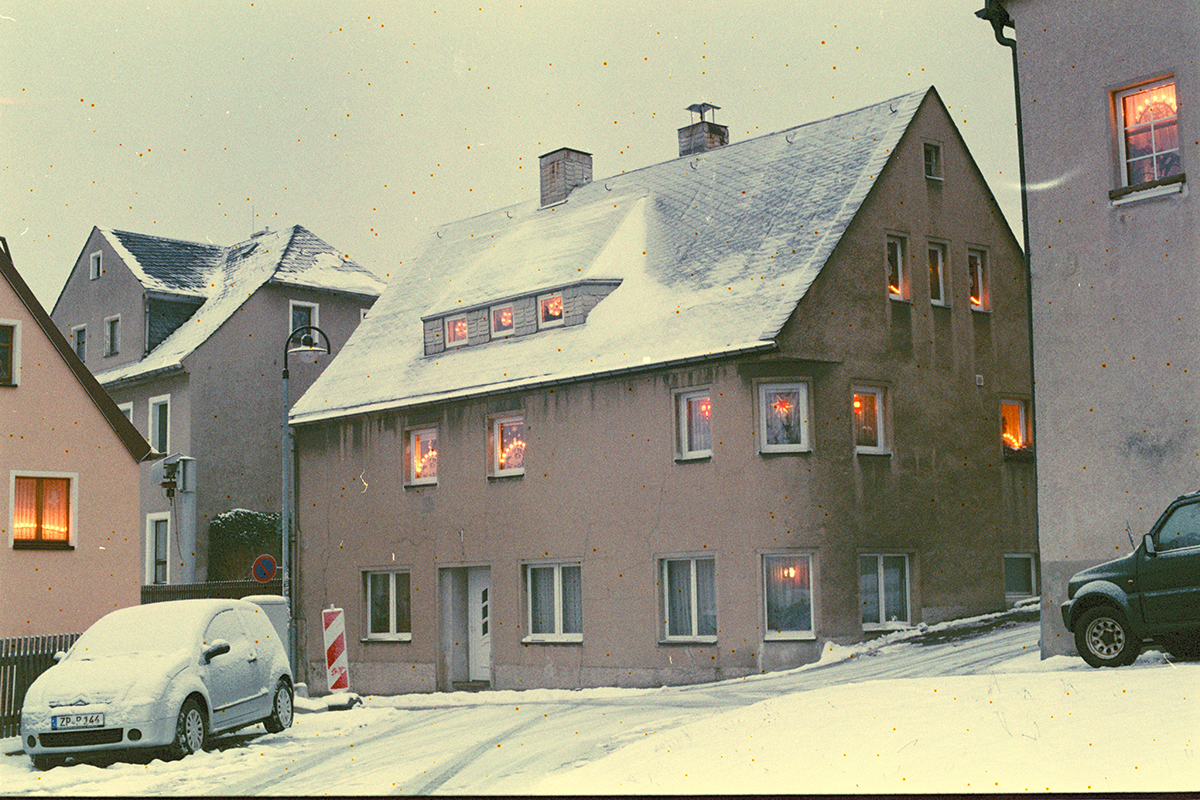
Related:
.Artistic research program ost in space in the Ore Mountains
.Comparative windows study
.Bibliography
DEUTSCH
„TRADITION“ ist eine Untersuchung des visuellen Lexikons und der Zusammenhänge zwischen Politik, Bergbau, Spiritualität, Volkskunst im Erzgebirge mittels Archiv- und Feldforschung, seit 2014.
Das Erzgebirge ist eine schmale Mittelgebirgsregion am östlichen Rande Deutschlands an der Grenze zu Tschechien, wo sich aus dem Einfluss von Religion auf die Bergbauindustrie über die Jahrhunderte eine einzigartige Mischung an Brauchtum entwickelt hat. Licht ist dabei z.B. ein wiederkehrendes Thema welches stark mit dem lichtbasiertem Medium Fotografie resoniert, mit dem ich arbeite. Industriell ist die Region vielfältig aufgestellt, traditionelle Holzkunst und neue Energien stehen Seite an Seite. Ich konzentriere mich auf heutige und einst zelebrierte Traditionen im Erzgebirge, und katalogisiere sie, um sie dann spielerisch zu dekonstruieren, und ihre Bedeutung als ideologisch aufgeladene Instrumente im Kontext der gesellschftlichen und politischen Entwicklung deutscher Geschichte zu untersuchen.
Mich interessiert auch die Rolle, welche die erzgebirgische Identität und Folklore in der Mythisierung der sogenannten “Deutschen Weihnacht” gespielt haben, welche durch die Bemühungen der Nationalsozialisten bis heute, auch international, nachwirkt. Generell ist die Eigenwahrnemung innerhalb der Region und die Außenwahrnehmung des Erzgebirges für mich von Interesse.
Meine Methoden der Forschung sind Reisen vor Ort, Metaananalyse regionaler Periodika wie den Erzgebirgischen Heimatblättern, oder der Glückauf des Erzgebirgsvereins, aber auch der zeitgenössischen sächsischen Presse, Fotografie und Filmaufnahmen, sozial- und politikwissenschaftliche Literaturrecherche, Gespräche, Objektbau und Text.
Mein biographischer Hintergrund schwingt dabei mit. Ursprünglich wurzelt meine Beschäftigung mit dem Erzgebirge in meiner Kindheitsliebe für alles Weihnachtliche, die sich bis heute erhalten hat. Spätestens seit der Selbstenttarnung der rechtsextremen Terrorgruppe NSU, 2011, und der Festnahme des NSU-Helfers André Emingers, der in Johanngeorgenstadt aktiv war, rückte das Erzgebirge wieder in meine Wahrnehmung. Es verband sich mit meinen Erinnerungen an mein Aufwachsen in den 90ern, wo Berichte über Gewalt an „Ausländern“ in Ost und West nicht nur zur abendlichen Tagesschau gehörten, sondern von meiner Mutter auch als reale, alltäglich empfundene Bedrohung kommuniziert wurde. Ich wurde als „Ausländerin“ in meiner Grundschule im früherem Ost-Berlin in Prenzlauer Berg mit Ausgrenzung und später physischem und verbalem mobbing konfrontiert. 2013 und 2014 nahmen Berichte über die Ausbreitung der rechtsextremen NPD, Pegida-Demonstrationen und die AfD-Anhängerschaft in Sachsen und dem Erzgebirge ein Ausmaß an, dass mich dazu führte mich zu fragen, wie und ob die Volkskunst eigentlich in Zusammenhang mit Nazikult damals und heute zusammenhängen könnte.
Die knisternde Spannung zwischen „Fremdheit“ und „Anpassung“ ist für mich zugleich persönlich und faszinierendes Studienobjekt. Sachsen, und speziell Chemitz, Zwickau und das angrenzende Erzgebirge werden in der Medienlandschaft innerhalb Deutschlands, und zwischenzeitlich in 2018 sogar international, in Verbindung gebracht mit Berichten über rassistische Gewalt und den Aufstieg rechter Parteien. Auch aus biographischen Gründen interessiere ich mich für Deutschlands Rolle als zentraleuropäisches Bindeglied zwischen Westeuropa, Richtung Osten, über den Balkan und nach West Asien. Ich sehe eine Verbindung über Zeit und Raum hinweg vom porösen Post-Wende Ost-Berlin der 90er und eigenen Erfahrungen der (internalisierten) Xenophobie bzw. Rassismus, vom Erzgebirge bis in das Japan nach seiner Öffnung zum Westen im 19. Jahrhundert.
Videostills von Aufnahmen in Yerevan, aus meiner neuen laufenden Videoinstallation 'Kopie des Erzgebirges im sogenannten Fernen Osten'.
Seit April 2022 befinde ich mich zusammen mit Kuratorin und Kunsthistorikerin Sandy Becker im Aufbau des künstlerischen Forschungsprogramms ost in space im Erzgebirge.
ENGLISH
„TRADITION“ is an investigation of the visual lexicon and connection between politics, mining, spirituality, folklore art in the Erzgebirge / Ore Mountains, using archival and field research, since 2014.
The Ore Mountains are a narrow mountainous upland region at the eastern border of Germany by the Czech Republic where the influence of religion on the mining industry across centuries has created a unique mix of traditions and customs. Light for instance is a recurrent theme in these traditions, that resonates with the light based medium photography with which I work. The region is industrially diverse, traditional wood art and renewable energy sit side by side. I focus on contemporary and once celebrated traditions in the Ore Mountains, and catalogue them in order to deconstruct them playfully, and to examine their meaning as ideologically charged instruments in the context of societal and political German history.
To me of interest is also the role that erzgebirgische / Ore Mountain identity and folklore had in the mythization of the so called “German Christmas”, that, due to efforts of the national socialists, reverbs even globally, to this day. In general the self-perception in the region and the outer perception of the Ore Mountain are important to observe.
My methods of research are travels on location, meta analysis of regional periodical journals that have run for decades to more than a century, like the Erzgebirgische Heimatblätter, or the Glückauf of the Erzgebirgsvereins, but also contemporary saxonian press, photography, sound and film records, literary research from social political science, personal interviews, object and text.
My biographical background resonates throughout. My focus on the Erzgebirge is rooted in my childhood love for everything christmas, that has held up until now. At the latest since the self-disclosure of the right-wing extremist terror group NSU, 2011, and the arrest of NSU accomplice André Emingers, who was active in Johanngeorgenstadt, the Erzgebirge moved back into my perception. It connected with my memories of growing up in the 90s, where reports of violence against "foreigners" in East and West were not only part of the evening news, but were also communicated by my mother as a real, everyday threat. I was confronted with exclusion and later physical and verbal bullying as a 'foreigner' in my elementary school in former East Berlin in Prenzlauer Berg. In 2013 and 2014, reports about the spread of the far-right NPD, Pegida demonstrations, and AfD supporters in Saxony and the Ore Mountains took on a magnitude that led me to wonder how and if folk art could actually be related to Nazi worship then and now.
The sizzling tension between „foreignness“ and „conforming“ is for me both a personal and a fascinating object of study. In German media and in 2018 even internationally, Saxony, and especially Chemitz, Zwickau and the Erzgebirge / Ore Mountains are connected to reports on acts of racist violence and the uprising of right wing parties. Also because of biographical reasons I am interested in Germany’s role as a Central European link between Western Europe, towards the East, across the Balkans and West Asia. I am seeing a connection across time and space from the porous post-socialist East Berlin of the 90s, to my own experiences of (internalized) xenophobia and racism, from the Erzgebirge to Japan after its opening to the West after the 19th Century.
Videostills from recordings in Yerevan, from my new ongoing video installation 'Copy of the Erzgebirge/Ore Mountains in the so-called Far East'.
April 2022, initiator and co-founder of artistic research program ost in space in the Erzgebirge/Ore Mountains, since and co-runner with curator and art historian Sandy Becker.
Project history
2023 ost in space Exhibition. Schmeilhaus. Schneeberg/Erzgebirge, DE
2023 ost in space Symposion. Faculty for Applied Sciences. Schneeberg/Erzgebirge, DE
2020 Zona D Vertraute Welt/Trusted World. Gegenwarten / Presences. Kunstsammlungen Chemnitz. Chemnitz, DE
Notes
.Artistically I engaged with the region for the first time in 2015 when I curated an exhibition/Kuenstlerisch habe ich mich zuerst mit der Region 2015 beschaeftigt, als ich eine Ausstellung initiiert und kuratiert habe: Erzgebirgisches LaserAtomKraftwerk mit Pigmentfenster
